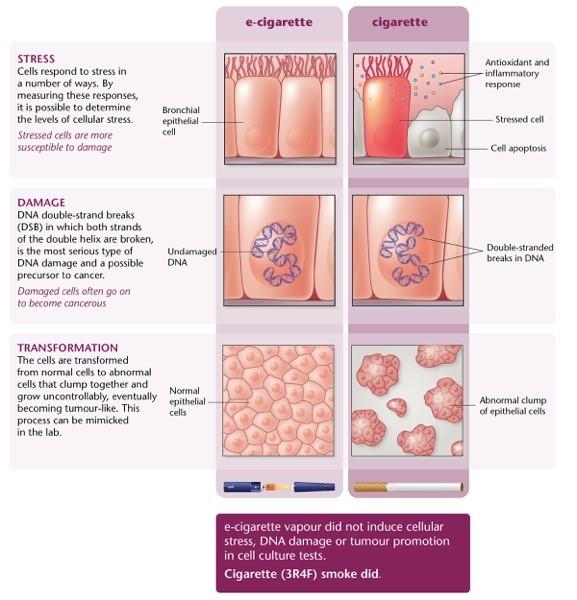In vitro tests of Vype vapor reveal no cell stress, DNA damage or cell transformation

Vype vapor produces the same result as an untreated control -- no activity in tests for cellular stress, double-strand DNA break and tumor promotion. Credit: British American Tobacco
A series of cell-based tests developed to compare the biological impact of cigarette smoke with e-cigarette vapour revealed no activity in cells exposed to vapour from Vype ePen, a commercially available e-cigarette. In contrast, when the cell culture systems were exposed to cigarette smoke, they exhibited a series of responses including stress responses, DNA damage and cellular transformation, depending on the assay used.
The use of these tests to assess the biological impact of e-cigarettes was reported by scientists from British American Tobacco at the annual meeting of the Society of Toxicology in New Orleans today.
'The results of these tests show that toxicity and biological activity is unaffected by the vapour from the e-cigarette tested, Vype ePen,' said Dr Kevin McAdam, Head of Next Generation Product (NGP) Research at British American Tobacco. 'These tests are part of a suite of tests being developed to test novel tobacco and nicotine products and could be used to help develop standards for these products in the future,' he said.
E-cigarette vapour can contain nicotine, humectants, flavourings and thermal degradation products, so it is important to understand the potential impact on biological systems.
A number of tests were used to compare the biological impact of cigarette smoke and e-cigarette vapour: cell stress tests, looking at the production of intracellular antioxidants, free radicals and inflammatory markers; assessment of DNA damage, which can set the scene for cancer; and a transformation assay, which measures the transformation or conversion of normal cells into a cancerous cell phenotype.
Stress
Cells respond to stress in a number of ways. They can produce compounds that protect the cellular structures or they can recruit compounds from the immune system to help protect the cell or commit suicide.
By measuring the levels of the various compounds produced and the level of cell apoptosis/death, it is possible to determine the levels of cellular stress.
The cell culture systems tested conventional 3R4F reference cigarette and Vype ePen, a commercially available e-cigarette. When cells were exposed to the cigarette smoke, all cell stress responses were activated. These same cell stress responses were not activated on exposure to e-cigarette vapour.
Damage
Cellular DNA can become damaged by exposure to toxicants, especially when stressed. DNA double-strand breaks (DSB) in which both strands of the double helix are broken, is the most serious type of DNA damage. This is a possible precursor to cancer and potentially lethal to the cell. The cell attempts to repair the DNA damage by modifying the histone or protein around which the DNA is wrapped. The changes observed in this histone can be used as an indicator of the level of DSB.
When this test was used to compare the impact of conventional 3R4F reference cigarette and Vype ePen on DSBs, the results showed that cigarette smoke induced significant DNA damage in human lung cells. This was dose dependent, that is, the higher the dose, the more DNA damage was induced. E-cigarette vapour produced no affect, even when the dose used was 15 times higher than the equivalent smoke exposure.
Disease
Damaged cells often go on to become cancerous. The cells are transformed from normal cells to abnormal cells that clump together and grow uncontrollably, eventually becoming tumour-like. This process can be mimicked in the lab by using cells that are already damaged and testing the tumour-promoting activities of different compounds.
In this case, the cell culture system was used to test the ability of conventional 3R4F reference cigarette and Vype ePen to promote tumour formation in a specialised cell type called Bhas 42.
After exposure to reference cigarettes, the layers of cells were seen to become transformed, clumping together to create colonies, suggesting that the smoke is a tumour promoter. By contrast, the e-cigarette produced no activity.
In each test, the e-cigarette produced the same results as an untreated control – there was no activity.
Many in the public health community believe that e-cigarettes are substantially reduced risk compared to cigarettes. Public Health England, an executive body of the UK Department of Health, recently published a report saying that e-cigarettes are 95% safer than cigarettes. But there are still no internationally agreed testing protocols to establish this.
Media Contact
All latest news from the category: Life Sciences and Chemistry
Articles and reports from the Life Sciences and chemistry area deal with applied and basic research into modern biology, chemistry and human medicine.
Valuable information can be found on a range of life sciences fields including bacteriology, biochemistry, bionics, bioinformatics, biophysics, biotechnology, genetics, geobotany, human biology, marine biology, microbiology, molecular biology, cellular biology, zoology, bioinorganic chemistry, microchemistry and environmental chemistry.
Newest articles

NASA: Mystery of life’s handedness deepens
The mystery of why life uses molecules with specific orientations has deepened with a NASA-funded discovery that RNA — a key molecule thought to have potentially held the instructions for…

What are the effects of historic lithium mining on water quality?
Study reveals low levels of common contaminants but high levels of other elements in waters associated with an abandoned lithium mine. Lithium ore and mining waste from a historic lithium…

Quantum-inspired design boosts efficiency of heat-to-electricity conversion
Rice engineers take unconventional route to improving thermophotovoltaic systems. Researchers at Rice University have found a new way to improve a key element of thermophotovoltaic (TPV) systems, which convert heat…



